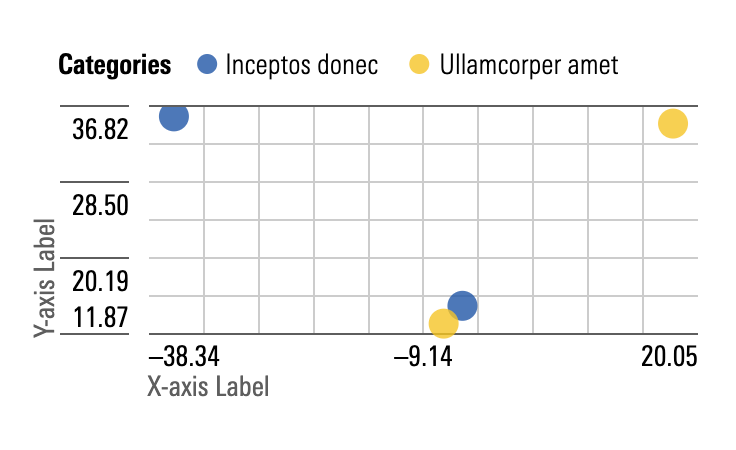Scatter Plot
Scatter Plot charts show the distribution of items relative to two axis variables.
Scatter Plot
Invalid Combination
Press Ctrl + C to copy
Guidelines
Use When
- Displaying the distribution of a set of items relative to two axis variables.
Don′t Use When
- Displaying the distribution of a set of items relative to three variables, one of which is expressed through the size of the plotted item. Instead, use a Bubble chart.
- Representing the statistical correlations between pairs of variables in a set. Instead, use a Correlation Matrix.
Visual Language
- Never use colors other than those defined in the visualization palette.
- Always use the relevant color orders and meanings from the visualization palette.
- Use hover crosshairs when it is important to be able to see a plotted item’s exact placement on each axis.
Legend
- At chart container widths of
600pxor less, the legend will move to the top of the chart. This is the default width for this behavior to occur, the width can be adjusted by setting thebreakpointparameter. - When the legend is at the top and contains more items than fit in the available space, the full legend is accessible within a Popover triggered by an Icon-Only Button.
 The Icon-Only Button provides access to the full legend within a Popover.
The Icon-Only Button provides access to the full legend within a Popover.
- The Popover containing the full legend includes logic to prevent it from overlapping the chart unless there is no space available to the right of, or above, the data visualization.
 The Popover containing the full legend has three potential positions based on the space available to the right of, and above, the chart.
The Popover containing the full legend has three potential positions based on the space available to the right of, and above, the chart.
Behaviors
- When hovering over items within the legend, the plotted items associated with that item become opaque, while all other plotted items and legend items fade back.
- When hovering over a plotted item, the plotted item and its matching legend item become opaque, while all other plotted items and legend items fade back. A tooltip appears, surfacing the underlying data values of the holding.
Responsiveness
- Scatter plots will resize to fill the available space. Avoid using them at widths below
200pxand heights below150pxto prevent axis value/label collision and clipping.
- Set the
breakpointparameter to control the width of the chart container (in pixels) at which the X-axis shows only the first, middle, and last X-axis value. Thebreakpointparameter also sets the size at which the legend moves to the top of the chart. By default, it is set to600.
 Scatter plot when it is smaller than the size passed in the
Scatter plot when it is smaller than the size passed in the breakpoint parameter.
- Set the
xAxisLabelBreakpointparameter to control the width of the chart container (in pixels) at which the X-axis shows show every other X-axis value. By default, it is set to800. - Consider limiting the number of decimal places shown in axis values to the amount that is useful to users. Longer axis values have a higher potential for issues at smaller sizes.
Editorial
- Strive for short, succinct axis labels and legend items that clearly describe the data.
- Include the unit or increment in axis labels.
Code Reference
Necessary code documentation can be found in the MBC repository.

